Analysis of Travelodge's Marketing Strategies and Promotional Mix
VerifiedAdded on 2021/10/13
|11
|2427
|28
Report
AI Summary
This report provides an in-depth analysis of Travelodge's marketing strategies, highlighting their marketing orientation, product orientation, and marketing environment. It examines legal and technological factors impacting Travelodge's operations, along with internal strengths and weaknesses. The report discusses marketing strategies, focusing on positioning and the marketing mix, including product, price, place, and promotion. Furthermore, it delves into Travelodge's integrated marketing communication approach, particularly their video campaign, analyzing the elements of the promotional mix, channels used for brand recognition, key messages, target audience, and the application of the AIDA model. The report concludes by discussing methods for collecting feedback to improve Travelodge's marketing efforts. This document is available on Desklib, a platform offering a wide range of study tools for students.
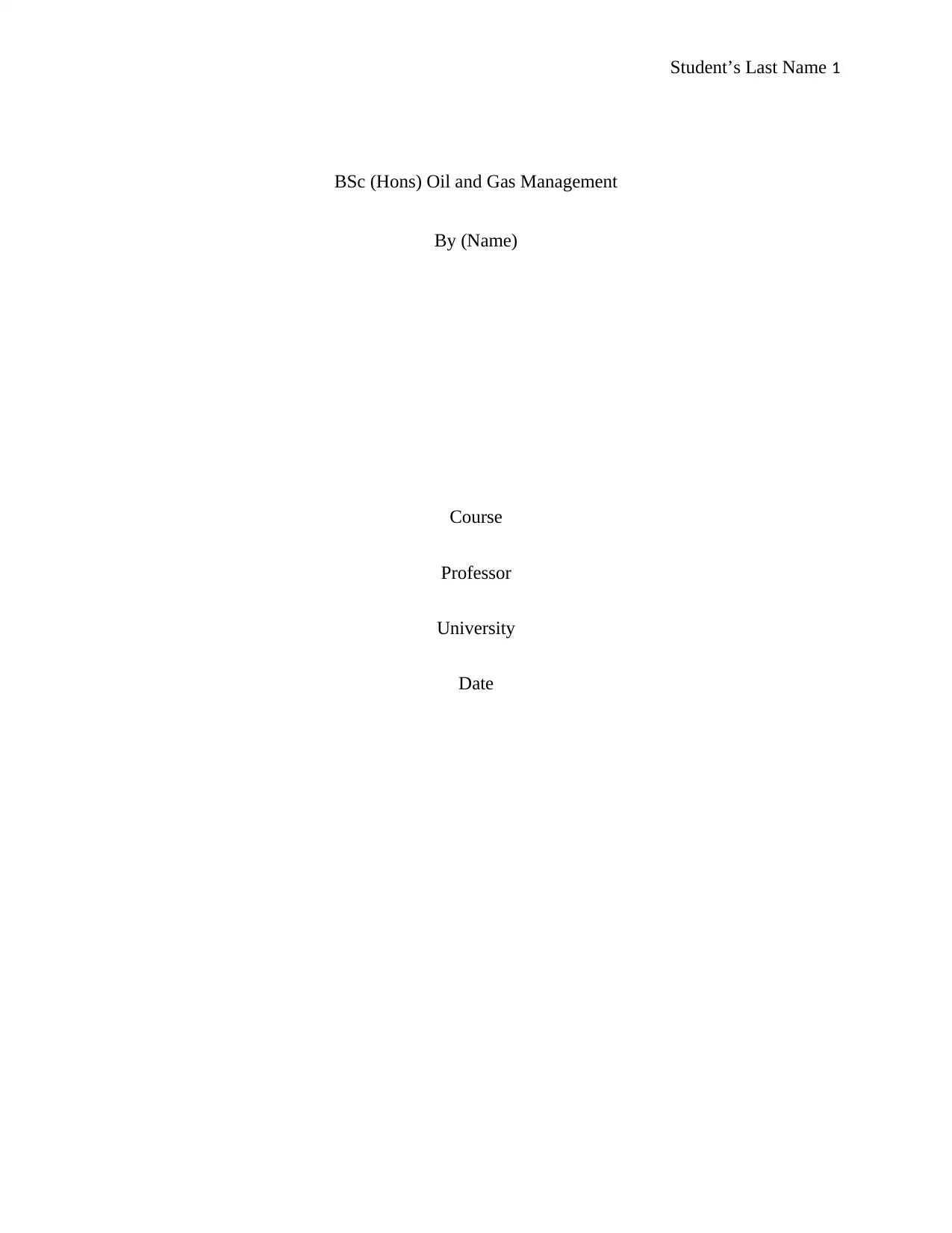
Student’s Last Name 1
BSc (Hons) Oil and Gas Management
By (Name)
Course
Professor
University
Date
BSc (Hons) Oil and Gas Management
By (Name)
Course
Professor
University
Date
Paraphrase This Document
Need a fresh take? Get an instant paraphrase of this document with our AI Paraphraser
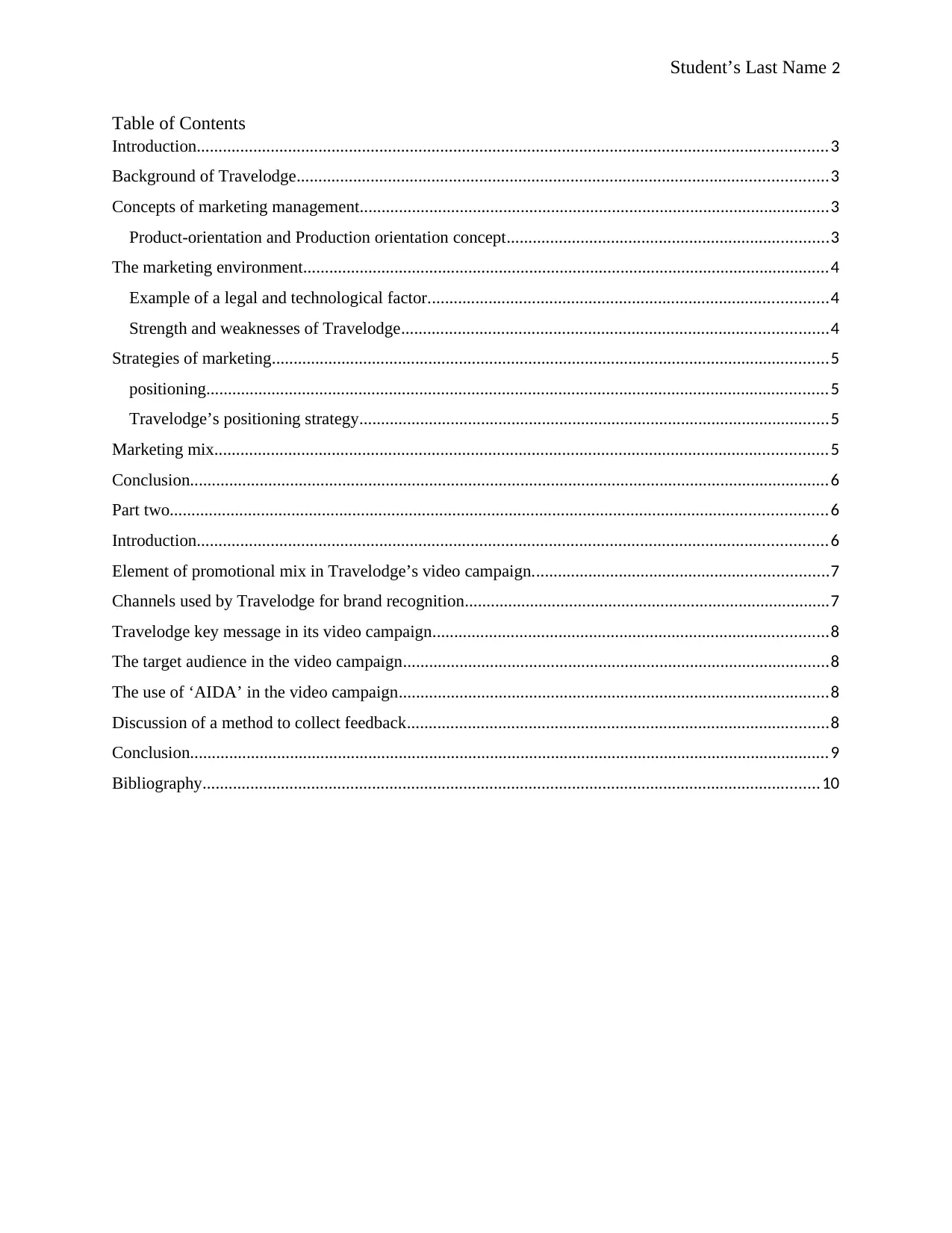
Student’s Last Name 2
Table of Contents
Introduction.................................................................................................................................................3
Background of Travelodge..........................................................................................................................3
Concepts of marketing management............................................................................................................3
Product-orientation and Production orientation concept..........................................................................3
The marketing environment.........................................................................................................................4
Example of a legal and technological factor............................................................................................4
Strength and weaknesses of Travelodge..................................................................................................4
Strategies of marketing................................................................................................................................5
positioning...............................................................................................................................................5
Travelodge’s positioning strategy............................................................................................................5
Marketing mix.............................................................................................................................................5
Conclusion...................................................................................................................................................6
Part two.......................................................................................................................................................6
Introduction.................................................................................................................................................6
Element of promotional mix in Travelodge’s video campaign....................................................................7
Channels used by Travelodge for brand recognition....................................................................................7
Travelodge key message in its video campaign...........................................................................................8
The target audience in the video campaign..................................................................................................8
The use of ‘AIDA’ in the video campaign...................................................................................................8
Discussion of a method to collect feedback.................................................................................................8
Conclusion...................................................................................................................................................9
Bibliography..............................................................................................................................................10
Table of Contents
Introduction.................................................................................................................................................3
Background of Travelodge..........................................................................................................................3
Concepts of marketing management............................................................................................................3
Product-orientation and Production orientation concept..........................................................................3
The marketing environment.........................................................................................................................4
Example of a legal and technological factor............................................................................................4
Strength and weaknesses of Travelodge..................................................................................................4
Strategies of marketing................................................................................................................................5
positioning...............................................................................................................................................5
Travelodge’s positioning strategy............................................................................................................5
Marketing mix.............................................................................................................................................5
Conclusion...................................................................................................................................................6
Part two.......................................................................................................................................................6
Introduction.................................................................................................................................................6
Element of promotional mix in Travelodge’s video campaign....................................................................7
Channels used by Travelodge for brand recognition....................................................................................7
Travelodge key message in its video campaign...........................................................................................8
The target audience in the video campaign..................................................................................................8
The use of ‘AIDA’ in the video campaign...................................................................................................8
Discussion of a method to collect feedback.................................................................................................8
Conclusion...................................................................................................................................................9
Bibliography..............................................................................................................................................10
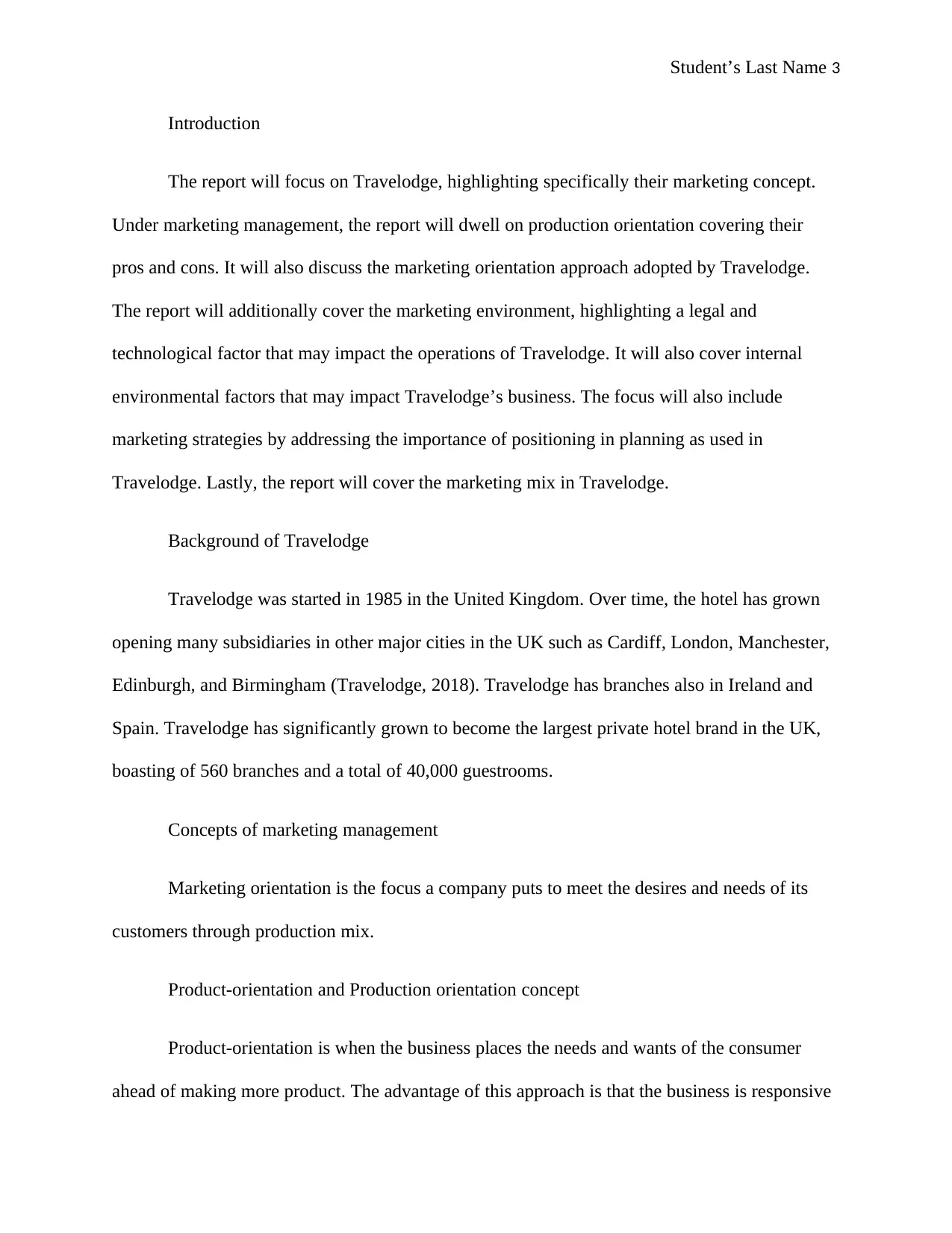
Student’s Last Name 3
Introduction
The report will focus on Travelodge, highlighting specifically their marketing concept.
Under marketing management, the report will dwell on production orientation covering their
pros and cons. It will also discuss the marketing orientation approach adopted by Travelodge.
The report will additionally cover the marketing environment, highlighting a legal and
technological factor that may impact the operations of Travelodge. It will also cover internal
environmental factors that may impact Travelodge’s business. The focus will also include
marketing strategies by addressing the importance of positioning in planning as used in
Travelodge. Lastly, the report will cover the marketing mix in Travelodge.
Background of Travelodge
Travelodge was started in 1985 in the United Kingdom. Over time, the hotel has grown
opening many subsidiaries in other major cities in the UK such as Cardiff, London, Manchester,
Edinburgh, and Birmingham (Travelodge, 2018). Travelodge has branches also in Ireland and
Spain. Travelodge has significantly grown to become the largest private hotel brand in the UK,
boasting of 560 branches and a total of 40,000 guestrooms.
Concepts of marketing management
Marketing orientation is the focus a company puts to meet the desires and needs of its
customers through production mix.
Product-orientation and Production orientation concept
Product-orientation is when the business places the needs and wants of the consumer
ahead of making more product. The advantage of this approach is that the business is responsive
Introduction
The report will focus on Travelodge, highlighting specifically their marketing concept.
Under marketing management, the report will dwell on production orientation covering their
pros and cons. It will also discuss the marketing orientation approach adopted by Travelodge.
The report will additionally cover the marketing environment, highlighting a legal and
technological factor that may impact the operations of Travelodge. It will also cover internal
environmental factors that may impact Travelodge’s business. The focus will also include
marketing strategies by addressing the importance of positioning in planning as used in
Travelodge. Lastly, the report will cover the marketing mix in Travelodge.
Background of Travelodge
Travelodge was started in 1985 in the United Kingdom. Over time, the hotel has grown
opening many subsidiaries in other major cities in the UK such as Cardiff, London, Manchester,
Edinburgh, and Birmingham (Travelodge, 2018). Travelodge has branches also in Ireland and
Spain. Travelodge has significantly grown to become the largest private hotel brand in the UK,
boasting of 560 branches and a total of 40,000 guestrooms.
Concepts of marketing management
Marketing orientation is the focus a company puts to meet the desires and needs of its
customers through production mix.
Product-orientation and Production orientation concept
Product-orientation is when the business places the needs and wants of the consumer
ahead of making more product. The advantage of this approach is that the business is responsive
⊘ This is a preview!⊘
Do you want full access?
Subscribe today to unlock all pages.

Trusted by 1+ million students worldwide
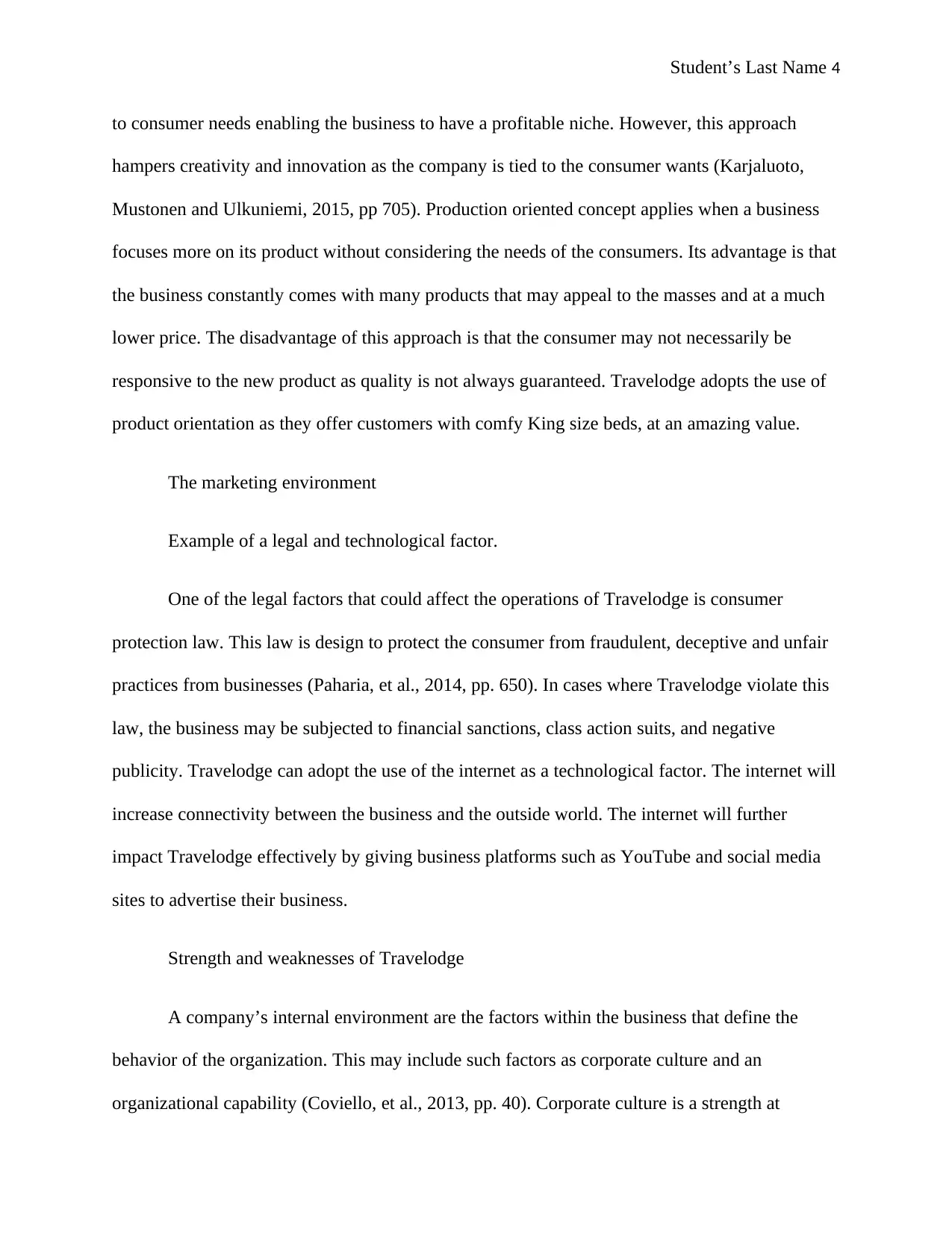
Student’s Last Name 4
to consumer needs enabling the business to have a profitable niche. However, this approach
hampers creativity and innovation as the company is tied to the consumer wants (Karjaluoto,
Mustonen and Ulkuniemi, 2015, pp 705). Production oriented concept applies when a business
focuses more on its product without considering the needs of the consumers. Its advantage is that
the business constantly comes with many products that may appeal to the masses and at a much
lower price. The disadvantage of this approach is that the consumer may not necessarily be
responsive to the new product as quality is not always guaranteed. Travelodge adopts the use of
product orientation as they offer customers with comfy King size beds, at an amazing value.
The marketing environment
Example of a legal and technological factor.
One of the legal factors that could affect the operations of Travelodge is consumer
protection law. This law is design to protect the consumer from fraudulent, deceptive and unfair
practices from businesses (Paharia, et al., 2014, pp. 650). In cases where Travelodge violate this
law, the business may be subjected to financial sanctions, class action suits, and negative
publicity. Travelodge can adopt the use of the internet as a technological factor. The internet will
increase connectivity between the business and the outside world. The internet will further
impact Travelodge effectively by giving business platforms such as YouTube and social media
sites to advertise their business.
Strength and weaknesses of Travelodge
A company’s internal environment are the factors within the business that define the
behavior of the organization. This may include such factors as corporate culture and an
organizational capability (Coviello, et al., 2013, pp. 40). Corporate culture is a strength at
to consumer needs enabling the business to have a profitable niche. However, this approach
hampers creativity and innovation as the company is tied to the consumer wants (Karjaluoto,
Mustonen and Ulkuniemi, 2015, pp 705). Production oriented concept applies when a business
focuses more on its product without considering the needs of the consumers. Its advantage is that
the business constantly comes with many products that may appeal to the masses and at a much
lower price. The disadvantage of this approach is that the consumer may not necessarily be
responsive to the new product as quality is not always guaranteed. Travelodge adopts the use of
product orientation as they offer customers with comfy King size beds, at an amazing value.
The marketing environment
Example of a legal and technological factor.
One of the legal factors that could affect the operations of Travelodge is consumer
protection law. This law is design to protect the consumer from fraudulent, deceptive and unfair
practices from businesses (Paharia, et al., 2014, pp. 650). In cases where Travelodge violate this
law, the business may be subjected to financial sanctions, class action suits, and negative
publicity. Travelodge can adopt the use of the internet as a technological factor. The internet will
increase connectivity between the business and the outside world. The internet will further
impact Travelodge effectively by giving business platforms such as YouTube and social media
sites to advertise their business.
Strength and weaknesses of Travelodge
A company’s internal environment are the factors within the business that define the
behavior of the organization. This may include such factors as corporate culture and an
organizational capability (Coviello, et al., 2013, pp. 40). Corporate culture is a strength at
Paraphrase This Document
Need a fresh take? Get an instant paraphrase of this document with our AI Paraphraser
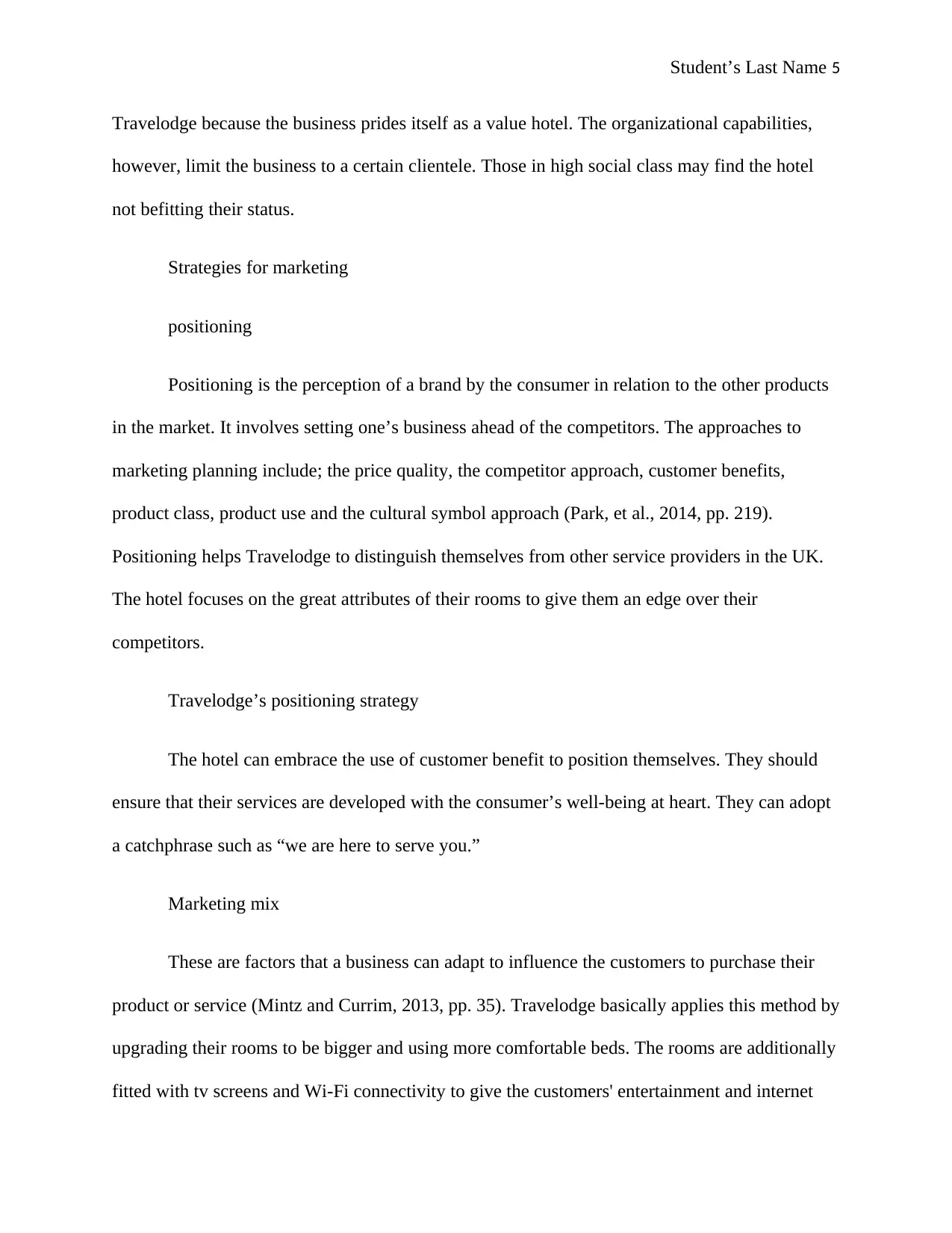
Student’s Last Name 5
Travelodge because the business prides itself as a value hotel. The organizational capabilities,
however, limit the business to a certain clientele. Those in high social class may find the hotel
not befitting their status.
Strategies for marketing
positioning
Positioning is the perception of a brand by the consumer in relation to the other products
in the market. It involves setting one’s business ahead of the competitors. The approaches to
marketing planning include; the price quality, the competitor approach, customer benefits,
product class, product use and the cultural symbol approach (Park, et al., 2014, pp. 219).
Positioning helps Travelodge to distinguish themselves from other service providers in the UK.
The hotel focuses on the great attributes of their rooms to give them an edge over their
competitors.
Travelodge’s positioning strategy
The hotel can embrace the use of customer benefit to position themselves. They should
ensure that their services are developed with the consumer’s well-being at heart. They can adopt
a catchphrase such as “we are here to serve you.”
Marketing mix
These are factors that a business can adapt to influence the customers to purchase their
product or service (Mintz and Currim, 2013, pp. 35). Travelodge basically applies this method by
upgrading their rooms to be bigger and using more comfortable beds. The rooms are additionally
fitted with tv screens and Wi-Fi connectivity to give the customers' entertainment and internet
Travelodge because the business prides itself as a value hotel. The organizational capabilities,
however, limit the business to a certain clientele. Those in high social class may find the hotel
not befitting their status.
Strategies for marketing
positioning
Positioning is the perception of a brand by the consumer in relation to the other products
in the market. It involves setting one’s business ahead of the competitors. The approaches to
marketing planning include; the price quality, the competitor approach, customer benefits,
product class, product use and the cultural symbol approach (Park, et al., 2014, pp. 219).
Positioning helps Travelodge to distinguish themselves from other service providers in the UK.
The hotel focuses on the great attributes of their rooms to give them an edge over their
competitors.
Travelodge’s positioning strategy
The hotel can embrace the use of customer benefit to position themselves. They should
ensure that their services are developed with the consumer’s well-being at heart. They can adopt
a catchphrase such as “we are here to serve you.”
Marketing mix
These are factors that a business can adapt to influence the customers to purchase their
product or service (Mintz and Currim, 2013, pp. 35). Travelodge basically applies this method by
upgrading their rooms to be bigger and using more comfortable beds. The rooms are additionally
fitted with tv screens and Wi-Fi connectivity to give the customers' entertainment and internet
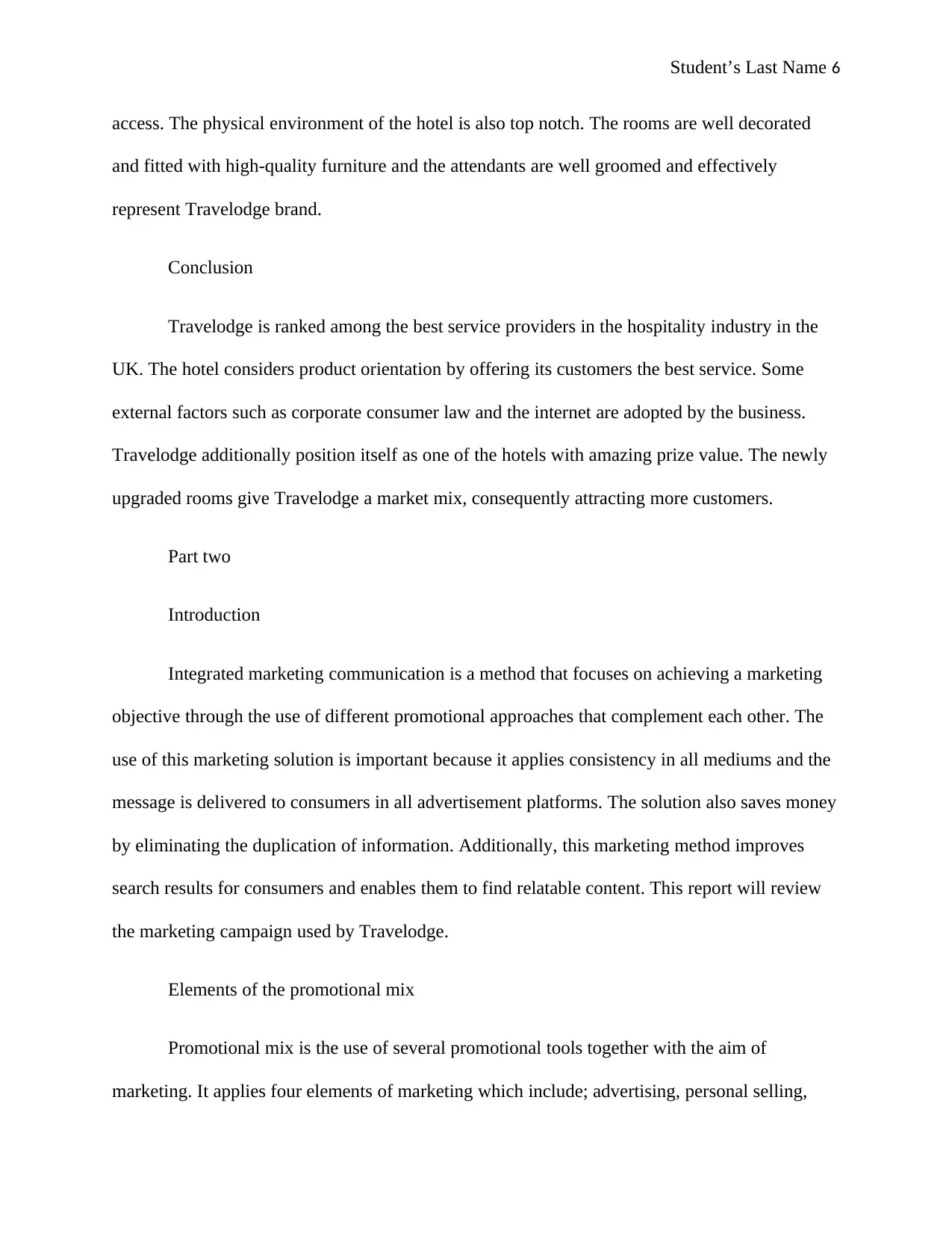
Student’s Last Name 6
access. The physical environment of the hotel is also top notch. The rooms are well decorated
and fitted with high-quality furniture and the attendants are well groomed and effectively
represent Travelodge brand.
Conclusion
Travelodge is ranked among the best service providers in the hospitality industry in the
UK. The hotel considers product orientation by offering its customers the best service. Some
external factors such as corporate consumer law and the internet are adopted by the business.
Travelodge additionally position itself as one of the hotels with amazing prize value. The newly
upgraded rooms give Travelodge a market mix, consequently attracting more customers.
Part two
Introduction
Integrated marketing communication is a method that focuses on achieving a marketing
objective through the use of different promotional approaches that complement each other. The
use of this marketing solution is important because it applies consistency in all mediums and the
message is delivered to consumers in all advertisement platforms. The solution also saves money
by eliminating the duplication of information. Additionally, this marketing method improves
search results for consumers and enables them to find relatable content. This report will review
the marketing campaign used by Travelodge.
Elements of the promotional mix
Promotional mix is the use of several promotional tools together with the aim of
marketing. It applies four elements of marketing which include; advertising, personal selling,
access. The physical environment of the hotel is also top notch. The rooms are well decorated
and fitted with high-quality furniture and the attendants are well groomed and effectively
represent Travelodge brand.
Conclusion
Travelodge is ranked among the best service providers in the hospitality industry in the
UK. The hotel considers product orientation by offering its customers the best service. Some
external factors such as corporate consumer law and the internet are adopted by the business.
Travelodge additionally position itself as one of the hotels with amazing prize value. The newly
upgraded rooms give Travelodge a market mix, consequently attracting more customers.
Part two
Introduction
Integrated marketing communication is a method that focuses on achieving a marketing
objective through the use of different promotional approaches that complement each other. The
use of this marketing solution is important because it applies consistency in all mediums and the
message is delivered to consumers in all advertisement platforms. The solution also saves money
by eliminating the duplication of information. Additionally, this marketing method improves
search results for consumers and enables them to find relatable content. This report will review
the marketing campaign used by Travelodge.
Elements of the promotional mix
Promotional mix is the use of several promotional tools together with the aim of
marketing. It applies four elements of marketing which include; advertising, personal selling,
⊘ This is a preview!⊘
Do you want full access?
Subscribe today to unlock all pages.

Trusted by 1+ million students worldwide
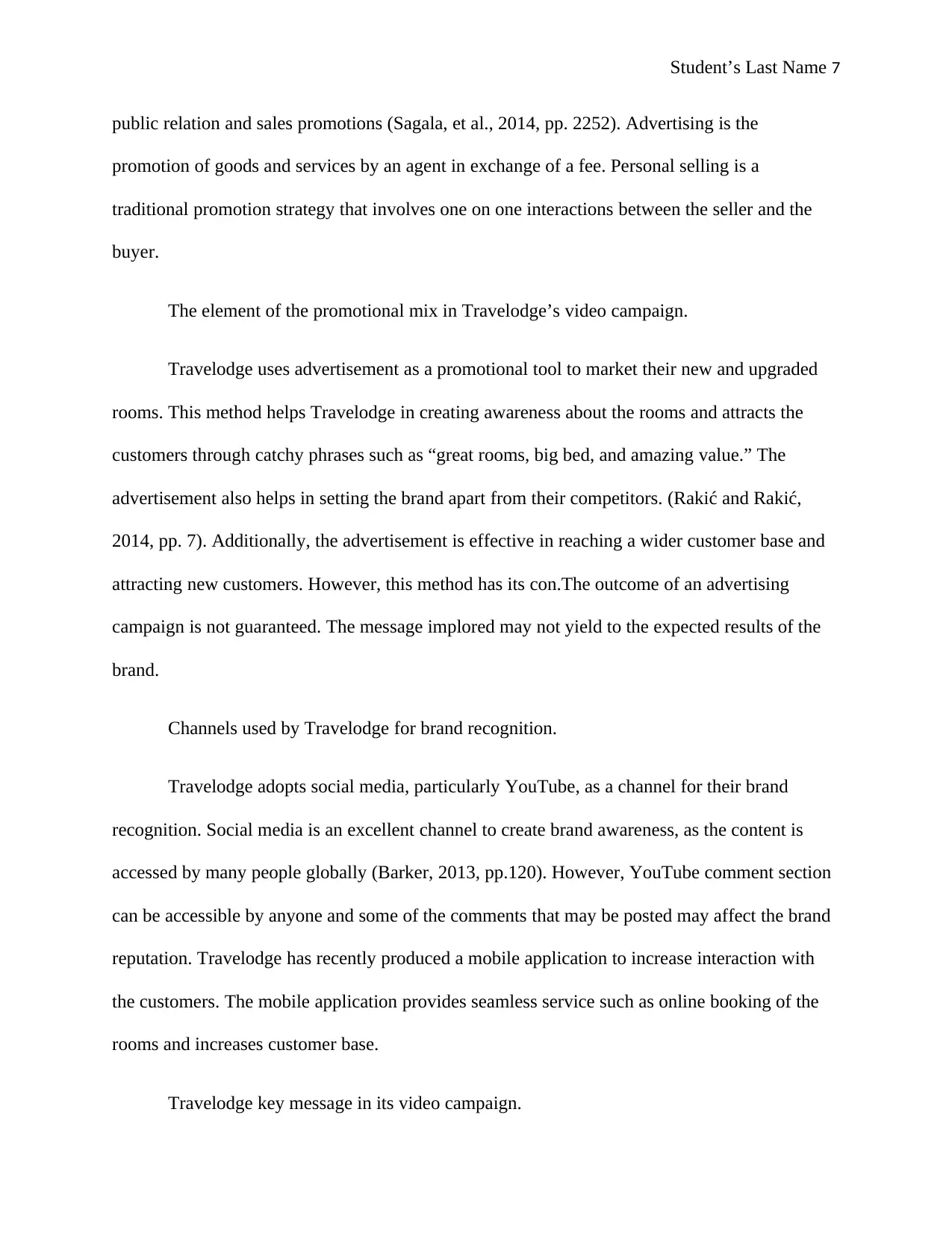
Student’s Last Name 7
public relation and sales promotions (Sagala, et al., 2014, pp. 2252). Advertising is the
promotion of goods and services by an agent in exchange of a fee. Personal selling is a
traditional promotion strategy that involves one on one interactions between the seller and the
buyer.
The element of the promotional mix in Travelodge’s video campaign.
Travelodge uses advertisement as a promotional tool to market their new and upgraded
rooms. This method helps Travelodge in creating awareness about the rooms and attracts the
customers through catchy phrases such as “great rooms, big bed, and amazing value.” The
advertisement also helps in setting the brand apart from their competitors. (Rakić and Rakić,
2014, pp. 7). Additionally, the advertisement is effective in reaching a wider customer base and
attracting new customers. However, this method has its con.The outcome of an advertising
campaign is not guaranteed. The message implored may not yield to the expected results of the
brand.
Channels used by Travelodge for brand recognition.
Travelodge adopts social media, particularly YouTube, as a channel for their brand
recognition. Social media is an excellent channel to create brand awareness, as the content is
accessed by many people globally (Barker, 2013, pp.120). However, YouTube comment section
can be accessible by anyone and some of the comments that may be posted may affect the brand
reputation. Travelodge has recently produced a mobile application to increase interaction with
the customers. The mobile application provides seamless service such as online booking of the
rooms and increases customer base.
Travelodge key message in its video campaign.
public relation and sales promotions (Sagala, et al., 2014, pp. 2252). Advertising is the
promotion of goods and services by an agent in exchange of a fee. Personal selling is a
traditional promotion strategy that involves one on one interactions between the seller and the
buyer.
The element of the promotional mix in Travelodge’s video campaign.
Travelodge uses advertisement as a promotional tool to market their new and upgraded
rooms. This method helps Travelodge in creating awareness about the rooms and attracts the
customers through catchy phrases such as “great rooms, big bed, and amazing value.” The
advertisement also helps in setting the brand apart from their competitors. (Rakić and Rakić,
2014, pp. 7). Additionally, the advertisement is effective in reaching a wider customer base and
attracting new customers. However, this method has its con.The outcome of an advertising
campaign is not guaranteed. The message implored may not yield to the expected results of the
brand.
Channels used by Travelodge for brand recognition.
Travelodge adopts social media, particularly YouTube, as a channel for their brand
recognition. Social media is an excellent channel to create brand awareness, as the content is
accessed by many people globally (Barker, 2013, pp.120). However, YouTube comment section
can be accessible by anyone and some of the comments that may be posted may affect the brand
reputation. Travelodge has recently produced a mobile application to increase interaction with
the customers. The mobile application provides seamless service such as online booking of the
rooms and increases customer base.
Travelodge key message in its video campaign.
Paraphrase This Document
Need a fresh take? Get an instant paraphrase of this document with our AI Paraphraser
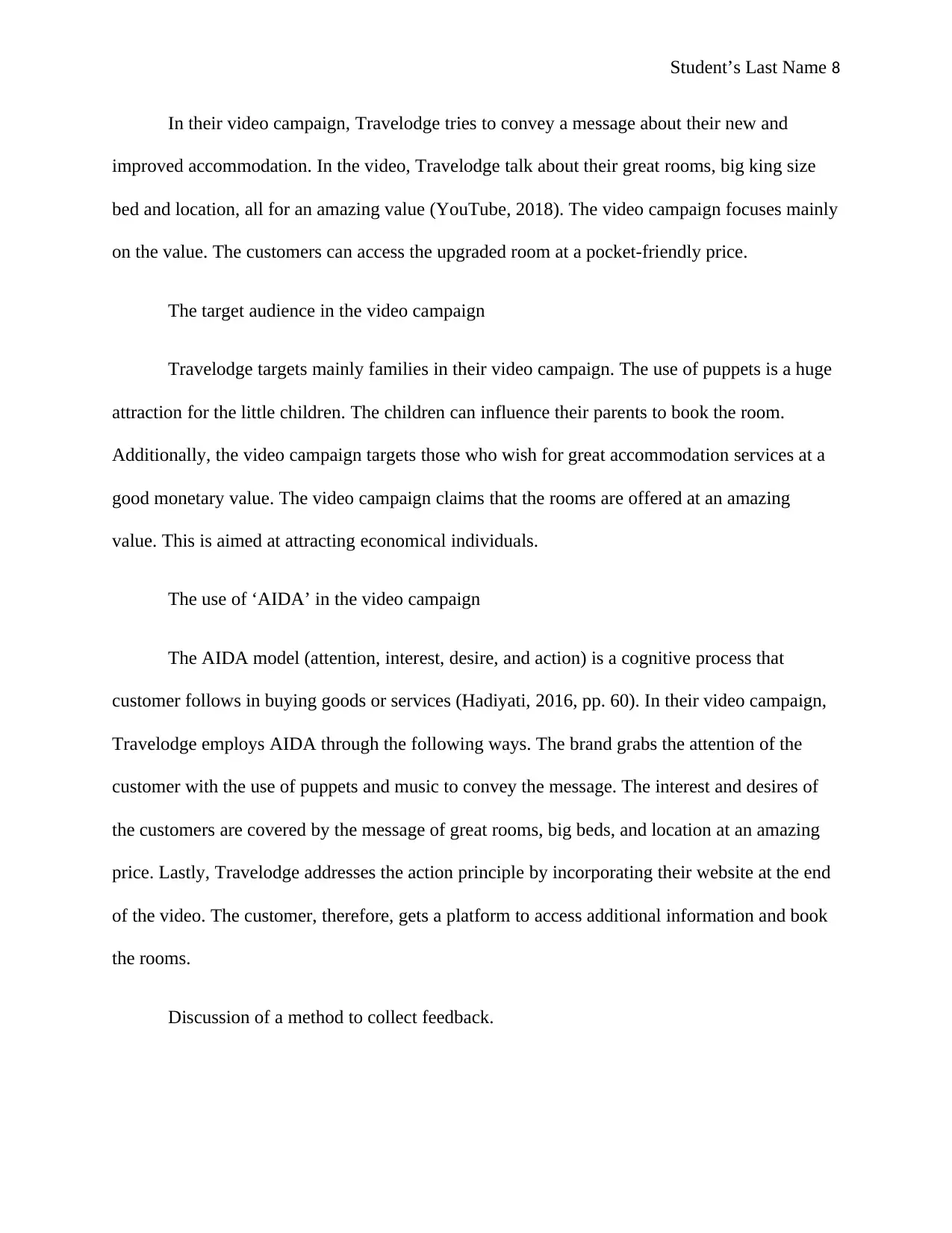
Student’s Last Name 8
In their video campaign, Travelodge tries to convey a message about their new and
improved accommodation. In the video, Travelodge talk about their great rooms, big king size
bed and location, all for an amazing value (YouTube, 2018). The video campaign focuses mainly
on the value. The customers can access the upgraded room at a pocket-friendly price.
The target audience in the video campaign
Travelodge targets mainly families in their video campaign. The use of puppets is a huge
attraction for the little children. The children can influence their parents to book the room.
Additionally, the video campaign targets those who wish for great accommodation services at a
good monetary value. The video campaign claims that the rooms are offered at an amazing
value. This is aimed at attracting economical individuals.
The use of ‘AIDA’ in the video campaign
The AIDA model (attention, interest, desire, and action) is a cognitive process that
customer follows in buying goods or services (Hadiyati, 2016, pp. 60). In their video campaign,
Travelodge employs AIDA through the following ways. The brand grabs the attention of the
customer with the use of puppets and music to convey the message. The interest and desires of
the customers are covered by the message of great rooms, big beds, and location at an amazing
price. Lastly, Travelodge addresses the action principle by incorporating their website at the end
of the video. The customer, therefore, gets a platform to access additional information and book
the rooms.
Discussion of a method to collect feedback.
In their video campaign, Travelodge tries to convey a message about their new and
improved accommodation. In the video, Travelodge talk about their great rooms, big king size
bed and location, all for an amazing value (YouTube, 2018). The video campaign focuses mainly
on the value. The customers can access the upgraded room at a pocket-friendly price.
The target audience in the video campaign
Travelodge targets mainly families in their video campaign. The use of puppets is a huge
attraction for the little children. The children can influence their parents to book the room.
Additionally, the video campaign targets those who wish for great accommodation services at a
good monetary value. The video campaign claims that the rooms are offered at an amazing
value. This is aimed at attracting economical individuals.
The use of ‘AIDA’ in the video campaign
The AIDA model (attention, interest, desire, and action) is a cognitive process that
customer follows in buying goods or services (Hadiyati, 2016, pp. 60). In their video campaign,
Travelodge employs AIDA through the following ways. The brand grabs the attention of the
customer with the use of puppets and music to convey the message. The interest and desires of
the customers are covered by the message of great rooms, big beds, and location at an amazing
price. Lastly, Travelodge addresses the action principle by incorporating their website at the end
of the video. The customer, therefore, gets a platform to access additional information and book
the rooms.
Discussion of a method to collect feedback.
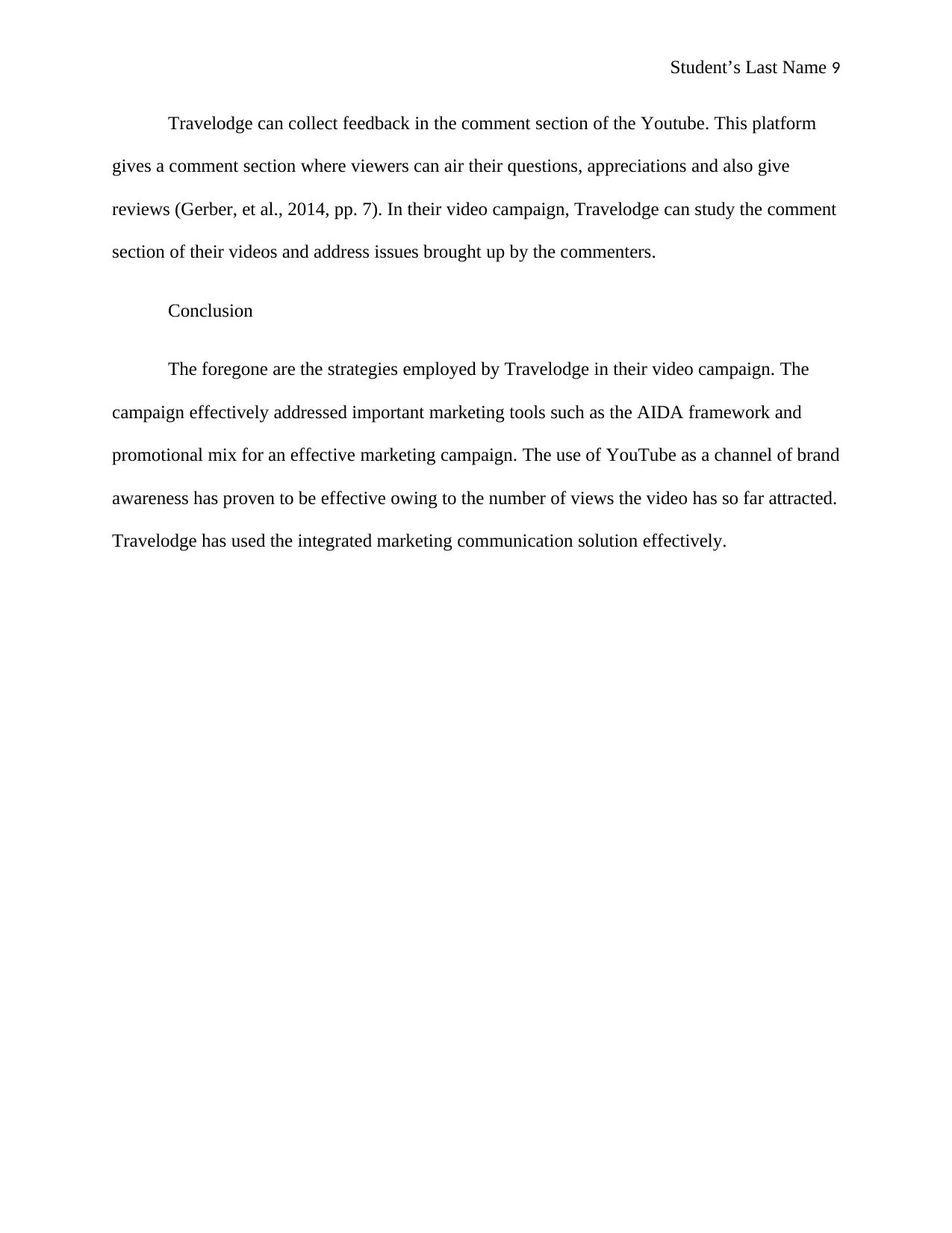
Student’s Last Name 9
Travelodge can collect feedback in the comment section of the Youtube. This platform
gives a comment section where viewers can air their questions, appreciations and also give
reviews (Gerber, et al., 2014, pp. 7). In their video campaign, Travelodge can study the comment
section of their videos and address issues brought up by the commenters.
Conclusion
The foregone are the strategies employed by Travelodge in their video campaign. The
campaign effectively addressed important marketing tools such as the AIDA framework and
promotional mix for an effective marketing campaign. The use of YouTube as a channel of brand
awareness has proven to be effective owing to the number of views the video has so far attracted.
Travelodge has used the integrated marketing communication solution effectively.
Travelodge can collect feedback in the comment section of the Youtube. This platform
gives a comment section where viewers can air their questions, appreciations and also give
reviews (Gerber, et al., 2014, pp. 7). In their video campaign, Travelodge can study the comment
section of their videos and address issues brought up by the commenters.
Conclusion
The foregone are the strategies employed by Travelodge in their video campaign. The
campaign effectively addressed important marketing tools such as the AIDA framework and
promotional mix for an effective marketing campaign. The use of YouTube as a channel of brand
awareness has proven to be effective owing to the number of views the video has so far attracted.
Travelodge has used the integrated marketing communication solution effectively.
⊘ This is a preview!⊘
Do you want full access?
Subscribe today to unlock all pages.

Trusted by 1+ million students worldwide
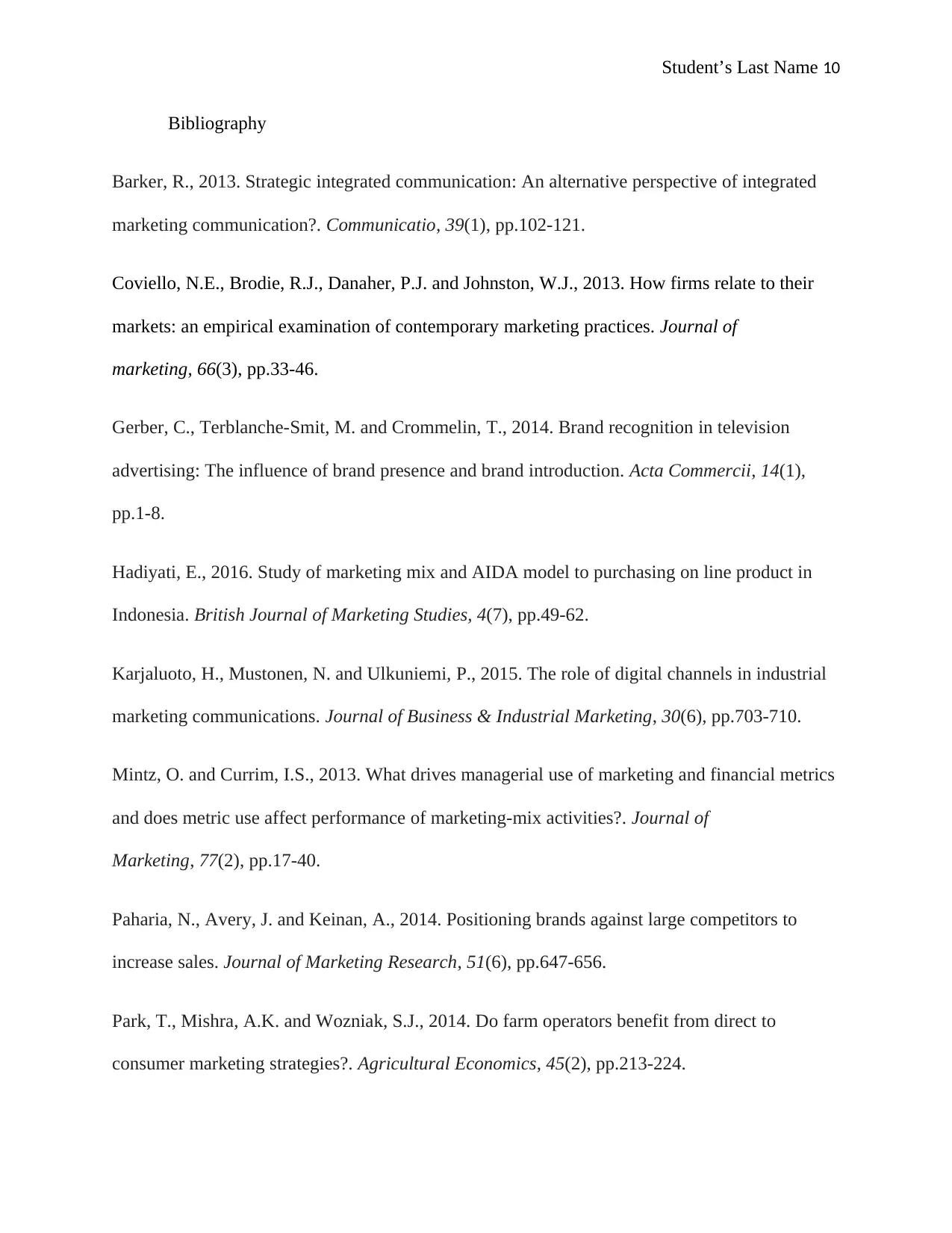
Student’s Last Name 10
Bibliography
Barker, R., 2013. Strategic integrated communication: An alternative perspective of integrated
marketing communication?. Communicatio, 39(1), pp.102-121.
Coviello, N.E., Brodie, R.J., Danaher, P.J. and Johnston, W.J., 2013. How firms relate to their
markets: an empirical examination of contemporary marketing practices. Journal of
marketing, 66(3), pp.33-46.
Gerber, C., Terblanche-Smit, M. and Crommelin, T., 2014. Brand recognition in television
advertising: The influence of brand presence and brand introduction. Acta Commercii, 14(1),
pp.1-8.
Hadiyati, E., 2016. Study of marketing mix and AIDA model to purchasing on line product in
Indonesia. British Journal of Marketing Studies, 4(7), pp.49-62.
Karjaluoto, H., Mustonen, N. and Ulkuniemi, P., 2015. The role of digital channels in industrial
marketing communications. Journal of Business & Industrial Marketing, 30(6), pp.703-710.
Mintz, O. and Currim, I.S., 2013. What drives managerial use of marketing and financial metrics
and does metric use affect performance of marketing-mix activities?. Journal of
Marketing, 77(2), pp.17-40.
Paharia, N., Avery, J. and Keinan, A., 2014. Positioning brands against large competitors to
increase sales. Journal of Marketing Research, 51(6), pp.647-656.
Park, T., Mishra, A.K. and Wozniak, S.J., 2014. Do farm operators benefit from direct to
consumer marketing strategies?. Agricultural Economics, 45(2), pp.213-224.
Bibliography
Barker, R., 2013. Strategic integrated communication: An alternative perspective of integrated
marketing communication?. Communicatio, 39(1), pp.102-121.
Coviello, N.E., Brodie, R.J., Danaher, P.J. and Johnston, W.J., 2013. How firms relate to their
markets: an empirical examination of contemporary marketing practices. Journal of
marketing, 66(3), pp.33-46.
Gerber, C., Terblanche-Smit, M. and Crommelin, T., 2014. Brand recognition in television
advertising: The influence of brand presence and brand introduction. Acta Commercii, 14(1),
pp.1-8.
Hadiyati, E., 2016. Study of marketing mix and AIDA model to purchasing on line product in
Indonesia. British Journal of Marketing Studies, 4(7), pp.49-62.
Karjaluoto, H., Mustonen, N. and Ulkuniemi, P., 2015. The role of digital channels in industrial
marketing communications. Journal of Business & Industrial Marketing, 30(6), pp.703-710.
Mintz, O. and Currim, I.S., 2013. What drives managerial use of marketing and financial metrics
and does metric use affect performance of marketing-mix activities?. Journal of
Marketing, 77(2), pp.17-40.
Paharia, N., Avery, J. and Keinan, A., 2014. Positioning brands against large competitors to
increase sales. Journal of Marketing Research, 51(6), pp.647-656.
Park, T., Mishra, A.K. and Wozniak, S.J., 2014. Do farm operators benefit from direct to
consumer marketing strategies?. Agricultural Economics, 45(2), pp.213-224.
Paraphrase This Document
Need a fresh take? Get an instant paraphrase of this document with our AI Paraphraser
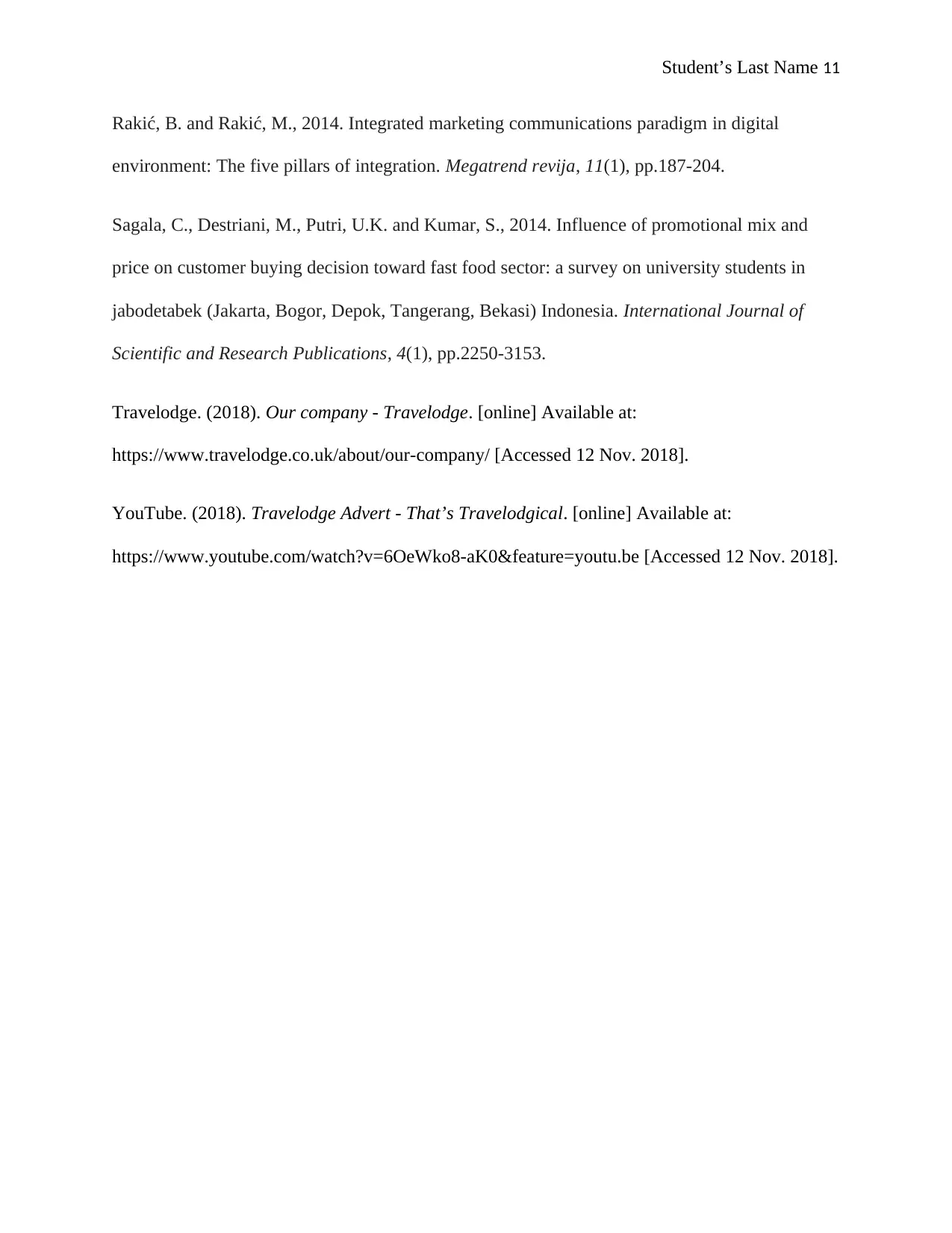
Student’s Last Name 11
Rakić, B. and Rakić, M., 2014. Integrated marketing communications paradigm in digital
environment: The five pillars of integration. Megatrend revija, 11(1), pp.187-204.
Sagala, C., Destriani, M., Putri, U.K. and Kumar, S., 2014. Influence of promotional mix and
price on customer buying decision toward fast food sector: a survey on university students in
jabodetabek (Jakarta, Bogor, Depok, Tangerang, Bekasi) Indonesia. International Journal of
Scientific and Research Publications, 4(1), pp.2250-3153.
Travelodge. (2018). Our company - Travelodge. [online] Available at:
https://www.travelodge.co.uk/about/our-company/ [Accessed 12 Nov. 2018].
YouTube. (2018). Travelodge Advert - That’s Travelodgical. [online] Available at:
https://www.youtube.com/watch?v=6OeWko8-aK0&feature=youtu.be [Accessed 12 Nov. 2018].
Rakić, B. and Rakić, M., 2014. Integrated marketing communications paradigm in digital
environment: The five pillars of integration. Megatrend revija, 11(1), pp.187-204.
Sagala, C., Destriani, M., Putri, U.K. and Kumar, S., 2014. Influence of promotional mix and
price on customer buying decision toward fast food sector: a survey on university students in
jabodetabek (Jakarta, Bogor, Depok, Tangerang, Bekasi) Indonesia. International Journal of
Scientific and Research Publications, 4(1), pp.2250-3153.
Travelodge. (2018). Our company - Travelodge. [online] Available at:
https://www.travelodge.co.uk/about/our-company/ [Accessed 12 Nov. 2018].
YouTube. (2018). Travelodge Advert - That’s Travelodgical. [online] Available at:
https://www.youtube.com/watch?v=6OeWko8-aK0&feature=youtu.be [Accessed 12 Nov. 2018].
1 out of 11
Related Documents
Your All-in-One AI-Powered Toolkit for Academic Success.
+13062052269
info@desklib.com
Available 24*7 on WhatsApp / Email
![[object Object]](/_next/static/media/star-bottom.7253800d.svg)
Unlock your academic potential
Copyright © 2020–2025 A2Z Services. All Rights Reserved. Developed and managed by ZUCOL.





